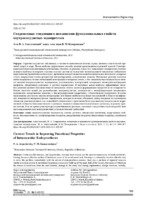| dc.contributor.author | Августовский, П. А. | |
| dc.contributor.author | Комаровская, В. М. | |
| dc.coverage.spatial | Минск | ru |
| dc.date.accessioned | 2023-06-19T11:14:30Z | |
| dc.date.available | 2023-06-19T11:14:30Z | |
| dc.date.issued | 2023 | |
| dc.identifier.citation | Августовский, П. А. Современные тенденции в повышении функциональных свойств внутрисосудистых эндопротезов = Current Trends in Improving Functional Properties of Intravascular Endoprostheses / П. А. Августовский, В. М. Комаровская // Наука и техника. – 2023. – № 3. – С. 199-207. | ru |
| dc.identifier.uri | https://rep.bntu.by/handle/data/129617 | |
| dc.description.abstract | Сердечно-сосудистые заболевания, в частности ишемическая болезнь сердца, являются самой частой причиной смерти в мире. Поиск наиболее эффективного способа лечения представляется передовой задачей. Стентирование выступает малоинвазивным действенным способом ее решения. Сразу же с появлением эндопротезов (стентов) возникла проблема повторного сужения сосудов (рестеноза) вследствие неоинтимальной гиперплазии (избыточное нарастание внутренней оболочки сосуда), причинами которой являются высвобождения ионов металлов из материала стента, повреждение стенки артерии при имплантировании, аллергические реакции. Изначально решение пытались найти посредством поиска оптимальной конструкции и материала стента, о чем свидетельствует выпуск более пятисот моделей внутрисосудистых эндопротезов, различающихся конструкцией, материалом, геометрической формой, профилем, габаритными размерами и другими параметрами. В настоящее время наиболее эффективным способом решения проблем биосовместимости материалов стентов является формирование покрытий на их поверхности. Можно выделить целый ряд разнообразных внутрисосудистых эндопротезов с модифицируемыми покрытиями: выделяющие лекарственные вещества, с биодеградируемыми покрытиями, с биоактивными покрытиями. В статье представлены результаты анализа литературных источников наиболее передовых исследований в области модификации поверхности внутрисосудистых эндопротезов, которые позволили обосновать выбор покрытия из оксинитрида титана как рекомендованного для дальнейшей оптимизации и применения благодаря высоким показателям по коррозионной стойкости, биосовместимости с клетками, тканями и жидкостями человеческого организма, хорошему уровню адгезии. В то же время существует ряд ограничивающих факторов, связанных с получением таких покрытий даже при выдерживании всех конструкционных и технологических требований. | ru |
| dc.language.iso | ru | ru |
| dc.publisher | БНТУ | ru |
| dc.title | Современные тенденции в повышении функциональных свойств внутрисосудистых эндопротезов | ru |
| dc.title.alternative | Current Trends in Improving Functional Properties of Intravascular Endoprostheses | ru |
| dc.type | Article | ru |
| dc.identifier.doi | 10.21122/2227-1031-2023-22-3-199-207 | |
| local.description.annotation | Cardiovascular diseases, and in particular, coronary heart disease are the most common cause of death worldwide. Finding the most effective method of treatment seems to be an advanced task. Stenting is a minimally invasive effective way to solve this problem. Immediately with the advent of endoprostheses (stents), there was a problem of repeated vasoconstriction (restenosis) due to neointimal hyperplasia (excessive build-up of the inner shell of the vessel), the causes of which are the release of metal ions from the stent material, damage to the artery wall during implantation, allergic reactions. Initially, they tried to find a solution by searching for the optimal design and material of the stent, as evidenced by the release of more than five hundred models of intravascular endoprostheses differing in design, material, geometric shape, profile, overall dimensions and other parameters. Currently, the most effective way to solve the problems of biocompatibility of stent materials is the formation of coatings on the surface of stents. It is possible to distinguish a number of different intravascular endoprostheses with modifiable coatings: secreting medicinal substances, with biodegradable coatings, with bioactive coatings. The paper presents the results of the analysis of the literature sources of the most advanced research in the field of surface modification of intravascular endoprostheses, which allowed to justify the choice of titanium oxynitride coating as recommended for further optimization and application due to high corrosion resistance, biocompatibility with cells, tissues and fluids of the human body, a good level of adhesion. At the same time there are a number of limiting factors associated with obtaining such coatings while maintaining all structural and technological requirements. | ru |

